A Through-Transmission Ultrasonic Method for the Detection of Ferrite Tile Defects
Abstract
:1. Introduction
2. Principle of Defect Detection by Liquid-Immersed Ultrasonic Transmission Method
3. Numerical Modeling
3.1. Establishment of Simulation Model
3.2. Analysis of Simulation Results
3.2.1. Ultrasonic Wave Propagation in the Medium
3.2.2. Detection Results of Different Defects at Different Locations
4. Design and Experimentation of the Ultrasonic Transmission System
4.1. Design of Defect Detection System
4.2. Experimental Operation and Data Processing
4.3. Experimental Results
4.3.1. Transmission Test of Aluminum Alloy Sample
4.3.2. Transmission Experiment of Ferrite Tiles
5. Conclusions
Author Contributions
Funding
Institutional Review Board Statement
Informed Consent Statement
Data Availability Statement
Acknowledgments
Conflicts of Interest
References
- Xie, L.; Xiang, X.; Xu, H.; Wang, L.; Lin, L.; Yin, G. FFCNN: A Deep Neural Network for Surface Defect Detection of Magnetic Tile. IEEE Trans. Ind. Electron. 2020, 68, 3506–3516. [Google Scholar] [CrossRef]
- Huang, Q.; Yin, Y.; Yin, G. Automatic classification of magnetic tiles internal defects based on acoustic resonance analysis. Mech. Syst. Signal Process. 2015, 60–61, 45–58. [Google Scholar] [CrossRef]
- Lu, H.; Zhu, Y.; Yin, M.; Yin, G.; Xie, L. Multimodal Fusion Convolutional Neural Network With Cross-Attention Mechanism for Internal Defect Detection of Magnetic Tile. IEEE Access 2022, 10, 60876–60886. [Google Scholar] [CrossRef]
- Wei, J.; Zhu, P.; Qian, X.; Zhu, S. One-stage object detection networks for inspecting the surface defects of magnetic tiles. In Proceedings of the 2019 IEEE International Conference on Imaging Systems and Techniques (IST), Abu Dhabi, United Arab Emirates, 9–10 December 2019; pp. 1–6. [Google Scholar] [CrossRef]
- Cao, X.; Yao, B.; Chen, B.; Wang, Y. Multi-defect detection for magnetic tile based on SE-U-Net. In Proceedings of the 2020 IEEE International Symposium on Product Compliance Engineering-Asia (ISPCE-CN), Chongqing, China, 6–8 November 2020; pp. 1–6. [Google Scholar] [CrossRef]
- Xie, L.; Yin, M.; Huang, Q.; Zhao, Y.; Deng, Z.; Xiang, Z.; Yin, G. Internal defect inspection in magnetic tile by using acoustic resonance technology. J. Sound Vib. 2016, 383, 108–123. [Google Scholar] [CrossRef]
- Hu, C.; Liao, H.; Zhou, T.; Zhu, A.; Xu, C. Online recognition of magnetic tile defects based on UPM-DenseNet. Mater. Today Commun. 2022, 30, 103105. [Google Scholar] [CrossRef]
- Yin, J.; Chen, S.; Wong, V.-K.; Yao, K. Thermal Sprayed Lead-Free Piezoelectric Ceramic Coatings for Ultrasonic Structural Health Monitoring. IEEE Trans. Ultrason. Ferroelectr. Freq. Control 2022, 69, 3070–3080. [Google Scholar] [CrossRef] [PubMed]
- Ozsoy, U.; Koyunlu, G.; Ugweje, O.C.; Dayyabu, A. Nondestructive testing of concrete using ultrasonic wave propagation. In Proceedings of the 2017 13th International Conference on Electronics, Computer and Computation (ICECCO), Abuja, Nigeria, 28–29 November 2017; pp. 1–5. [Google Scholar] [CrossRef]
- Mondal, S.; Datta, D. Ultrasonic Monitoring of Hardness of Industrial Rubbers. In Proceedings of the 2019 8th International Conference on Modeling Simulation and Applied Optimization (ICMSAO), Manama, Bahrain, 15–17 April 2019; pp. 1–6. [Google Scholar] [CrossRef]
- Liu, M. Ultrasonic Inspection And Defect Identification of Thin—Walled Stainless Steel Welded Pipe Weld. In Proceedings of the 2022 9th International Forum on Electrical Engineering and Automation (IFEEA), Zhuhai, China, 4–6 November 2022; pp. 995–998. [Google Scholar] [CrossRef]
- Cheng, Z.; Zhu, K.; Li, X.; Qian, X. Detection of Internal Defects Based on Empirical Mode Decomposition and Wavelets Denoising. In Proceedings of the 2021 IEEE Industrial Electronics and Applications Conference (IEACon), Penang, Malaysia, 22–23 November 2021; pp. 302–307. [Google Scholar] [CrossRef]
- Case, T.; Waag, R. Flaw identification from time and frequency features of ultrasonic waveforms. IEEE Trans. Ultrason. Ferroelectr. Freq. Control 1996, 43, 592–600. [Google Scholar] [CrossRef]
- Medak, D.; Posilovic, L.; Subasic, M.; Budimir, M.; Loncaric, S. Automated Defect Detection From Ultrasonic Images Using Deep Learning. IEEE Trans. Ultrason. Ferroelectr. Freq. Control 2021, 68, 3126–3134. [Google Scholar] [CrossRef]
- Li, K.; Wu, Y.; Guo, D.; Que, K.; Chen, B. A new method of ultrasonic featured-scan for composite materials. In Proceedings of the 2011 International Symposium on Applications of Ferroelectrics (ISAF/PFM) and 2011 International Symposium on Piezoresponse Force Microscopy and Nanoscale Phenomena in Polar Materials, Vancouver, BC, Canada, 24–27 July 2011; pp. 1–3. [Google Scholar] [CrossRef]
- Suryawanshi, V.J.; Pawar, A.C.; Palekar, S.P.; Rade, K.A. Defect detection of composite honeycomb structure by vibration analysis technique. Mater. Today Proc. 2020, 27, 2731–2735. [Google Scholar] [CrossRef]
- Benavente, D.; Galiana-Merino, J.; Pla, C.; Martinez-Martinez, J.; Crespo-Jimenez, D. Automatic detection and characterisation of the first P- and S-wave pulse in rocks using ultrasonic transmission method. Eng. Geol. 2020, 266, 105474. [Google Scholar] [CrossRef]
- Bang, S.J.; Song, D.G.; Jhang, K.Y. Comparisons of second- and third-order ultrasonic nonlinearity param-eters measured using through-transmission and pulse-echo methods. NDT E Int. 2023, 133, 102757. [Google Scholar] [CrossRef]
- Miyamoto, R.; Mizutani, K.; Ebihara, T.; Wakatsuki, N. Defect detection and size estimation in billet from profile of time-of-flight using ultrasonic transmission method with linear scanning. Jpn. J. Appl. Phys. 2015, 54, 07HC11. [Google Scholar] [CrossRef]
- Zhu, J.; Lin, Y.; Wang, B.; Wen, J.; Tian, R. Study on ultrasonic attenuation characteristics in air-droplet two-phase flow. Ann. Nucl. Energy 2023, 185, 109742. [Google Scholar] [CrossRef]
- Liu, H.; Tan, C.; Dong, F. Improved Amplitude Extraction Method for Attenuation Reconstruction of Transmissive Ultrasonic Tomography. In Proceedings of the 2022 IEEE International Instrumentation and Measurement Technology Conference (I2MTC), Ottawa, ON, Canada, 16–19 May 2022; pp. 1–6. [Google Scholar] [CrossRef]
- Wang, H.B. Study on Key Techniques of Ultrasonic Nondestructive Testing Composite Parts. Ph.D. Thesis, Beijing Institute of Technology, Beijing, China, 2014. [Google Scholar]
- Song, Y.Y.; Su, M.X.; Cai, X.S.; Shen, J.Q.; Xue, M.H. Computation of Acoustic Scattering by Rigid Particles by the Boundary Element Method. Chin. J. Process Eng. 2009, 9, 107–111. [Google Scholar]
- Huang, D.-H.; Liao, C.-K.; Wei, C.-W.; Li, P.-C. Simulations of optoacoustic wave propagation in light-absorbing media using the finite difference time-domain method. In Proceedings of the IEEE Ultrasonics Symposium, 2004, Montreal, QC, Canada, 23–27 August 2004. [Google Scholar] [CrossRef]
- Schwartz, H.; Pineau, J.-P.; Feuillard, G.; Prax, C.; Valiere, J.-C. Development of flow characterization system using ultrasonic methods. In Proceedings of the 2012 IEEE International Ultrasonics Symposium, Dresden, Germany, 7–10 October 2012; pp. 1–4. [Google Scholar] [CrossRef]
- Fang, L.; Yu, X.; Zeng, Q.; Zhao, N.; Li, X. Excitation Characteristics of Ultrasonic Probe. In Proceedings of the 2019 IEEE International Instru-mentation and Measurement Technology Conference (I2MTC), Auckland, New Zealand, 20–23 May 2019; pp. 1–6. [Google Scholar]
- Pereira, D.; Le Duff, A.; Painchaud-April, G.; Belanger, P. Simulation-Based Inversion for the Characterization of Adhe-sively Bonded Joints Using Ultrasonic Guided Waves. IEEE Trans. Ultrason. Ferroelectr. Freq. Control 2022, 69, 2400–2407. [Google Scholar] [CrossRef] [PubMed]
- Wang, M.; Zheng, D. Simulation Research on Liquid Film Thickness of Horizontal Gas-liquid Two-phase Flow Based on Ultrasonic Method. In Proceedings of the 2021 40th Chinese Control Conference (CCC), Shanghai, China, 26–28 July 2021. [Google Scholar] [CrossRef]
- Cheng, J.; He, C.; Lyu, Y.; Zheng, Y.; Xie, L.; Wu, L. Ultrasonic inspection of the surface crack for the main shaft of a wind turbine from the end face. NDT E Int. 2020, 114, 102283. [Google Scholar] [CrossRef]
- Dong, J.B.; Gao, H.B.; Zhang, S.J. Simulation Research and Experimental Verification of Non-defect Echoes by Ultra-sonic Testing. Res. Explor. Lab. 2022, 41, 110–116. [Google Scholar]


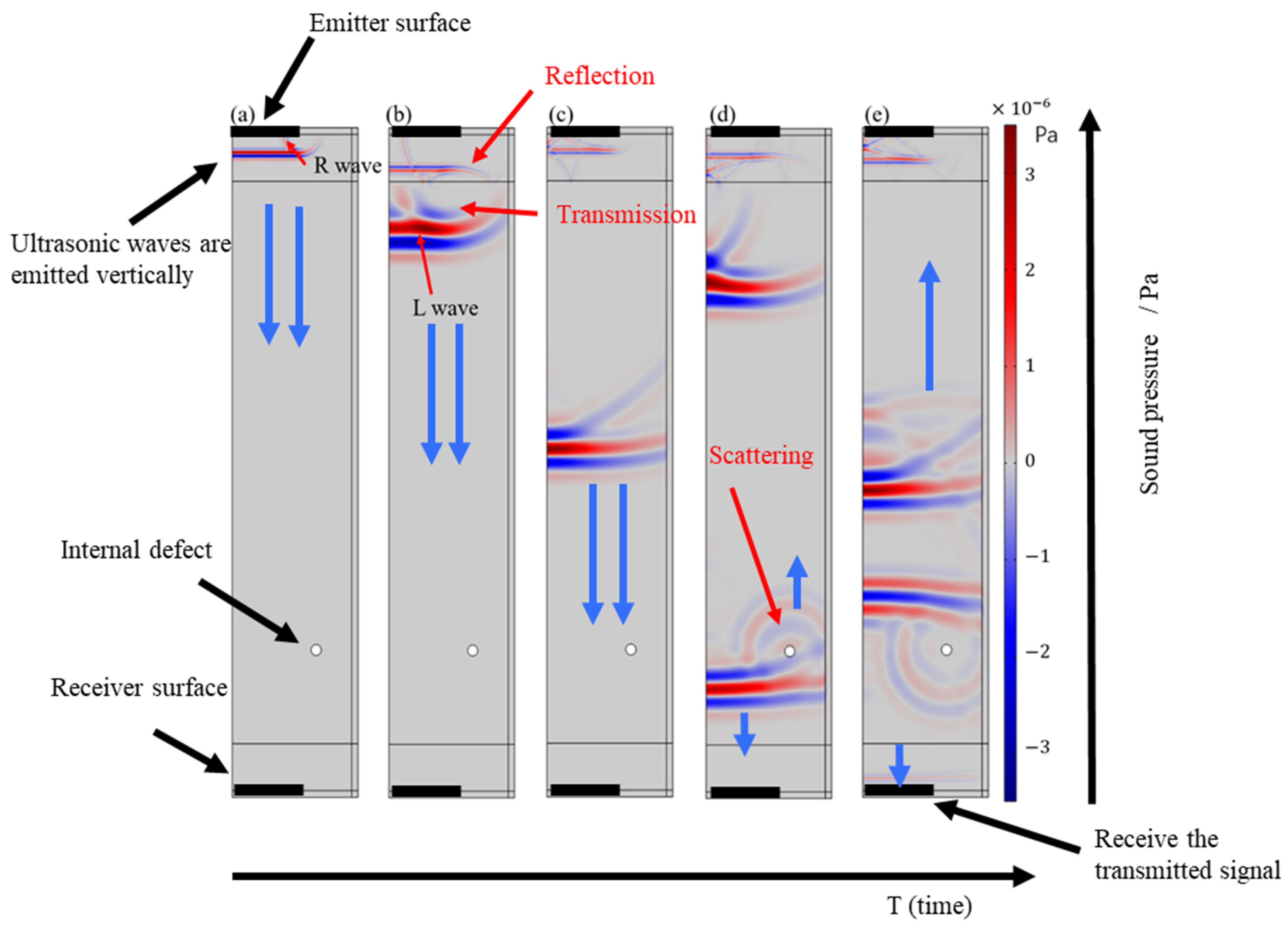
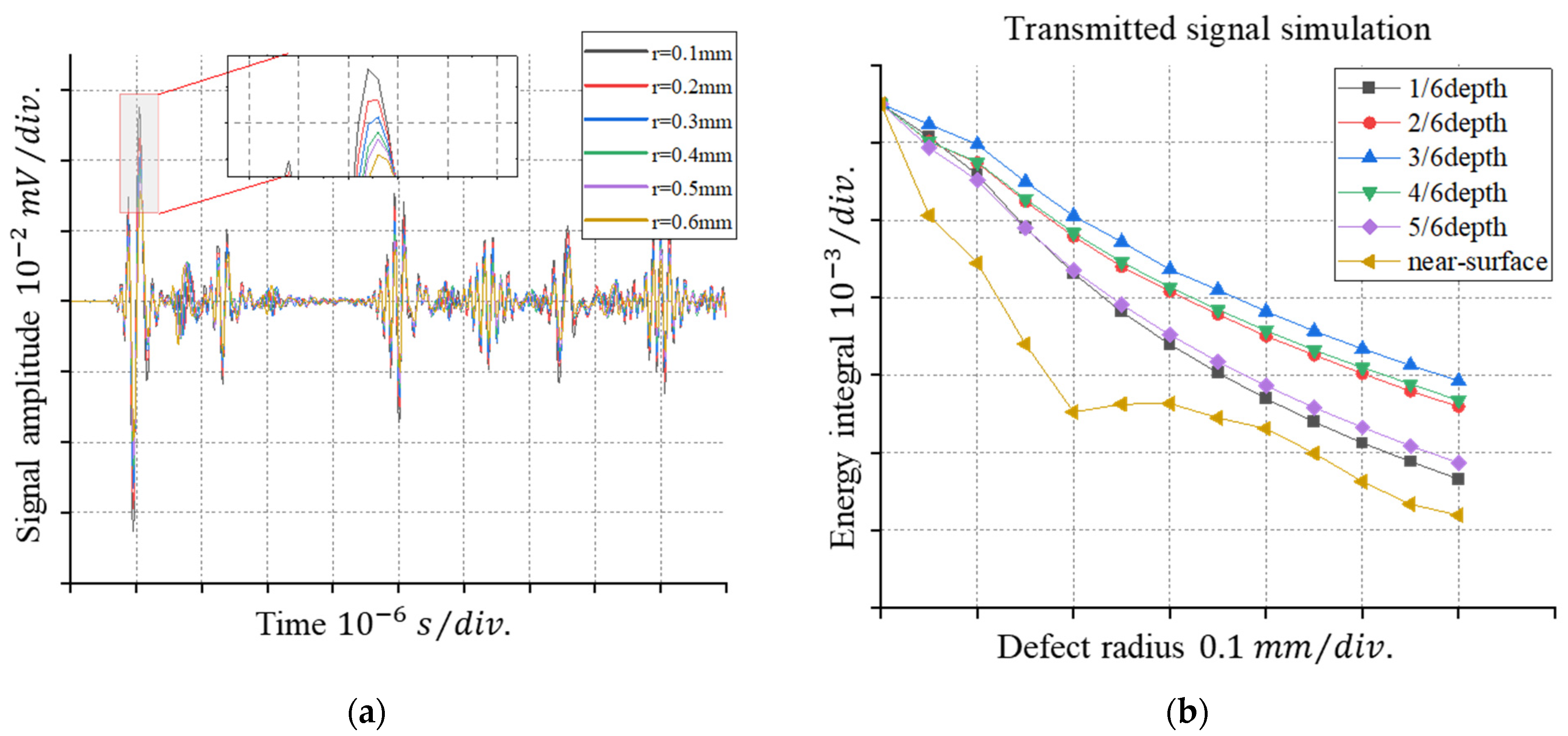



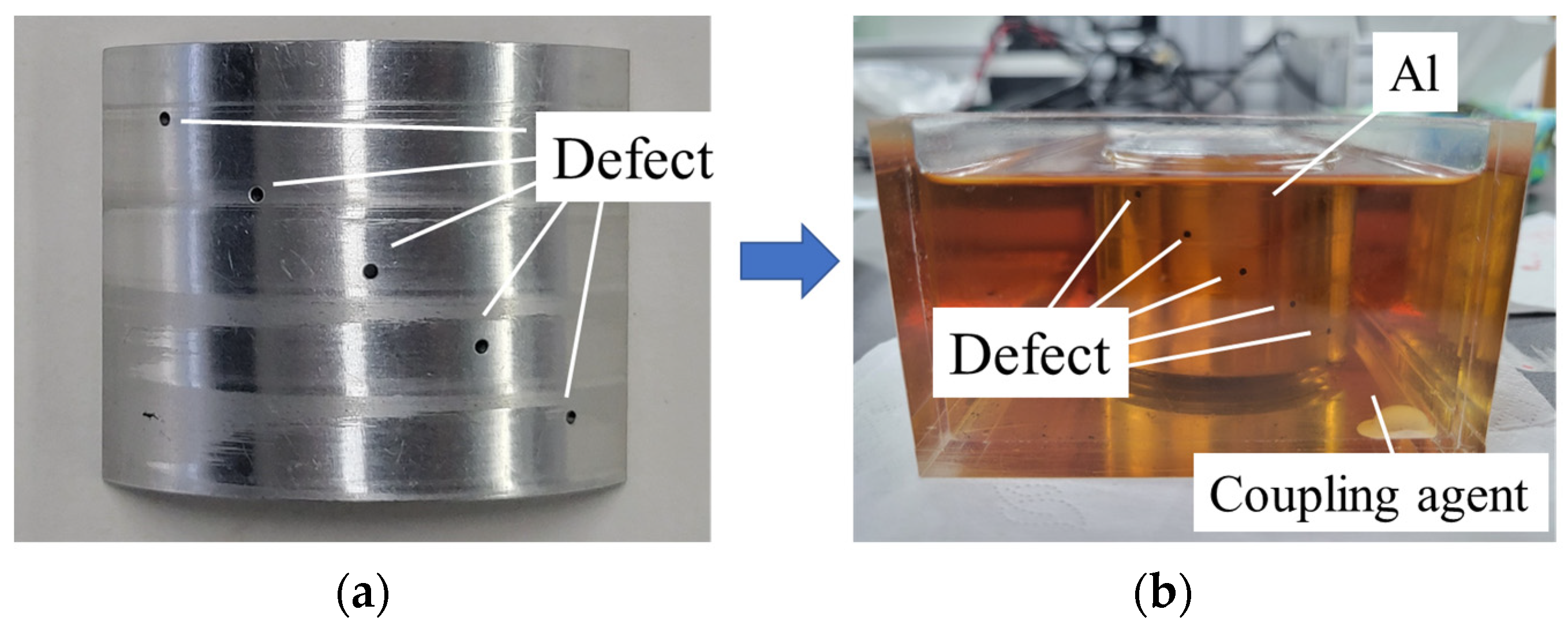
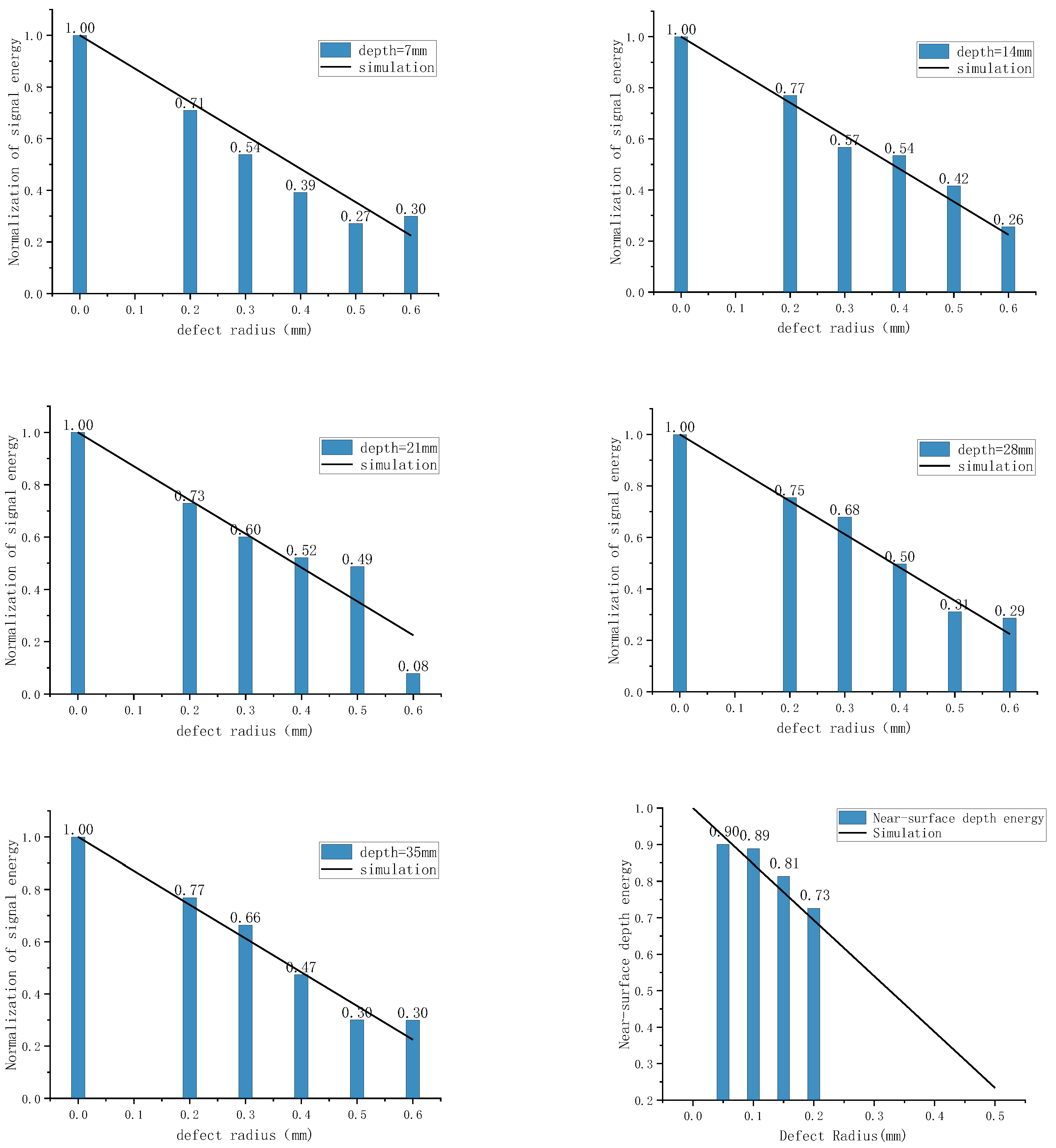
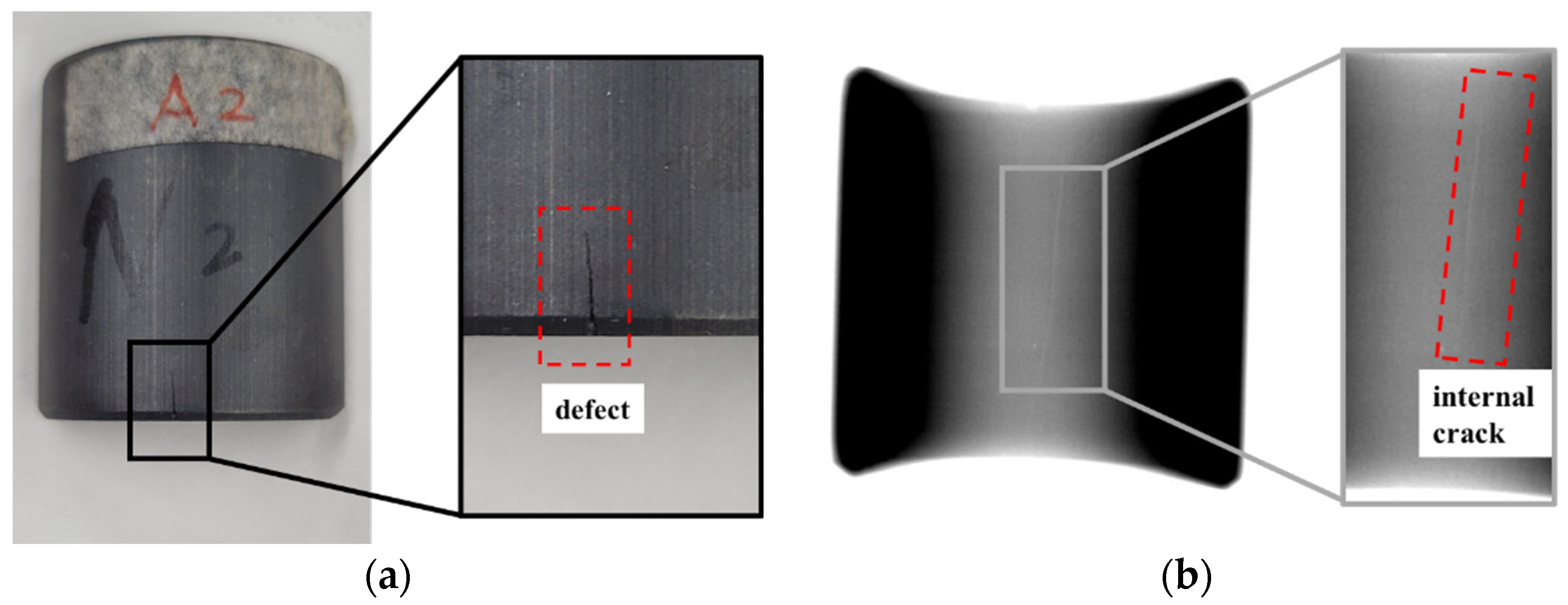
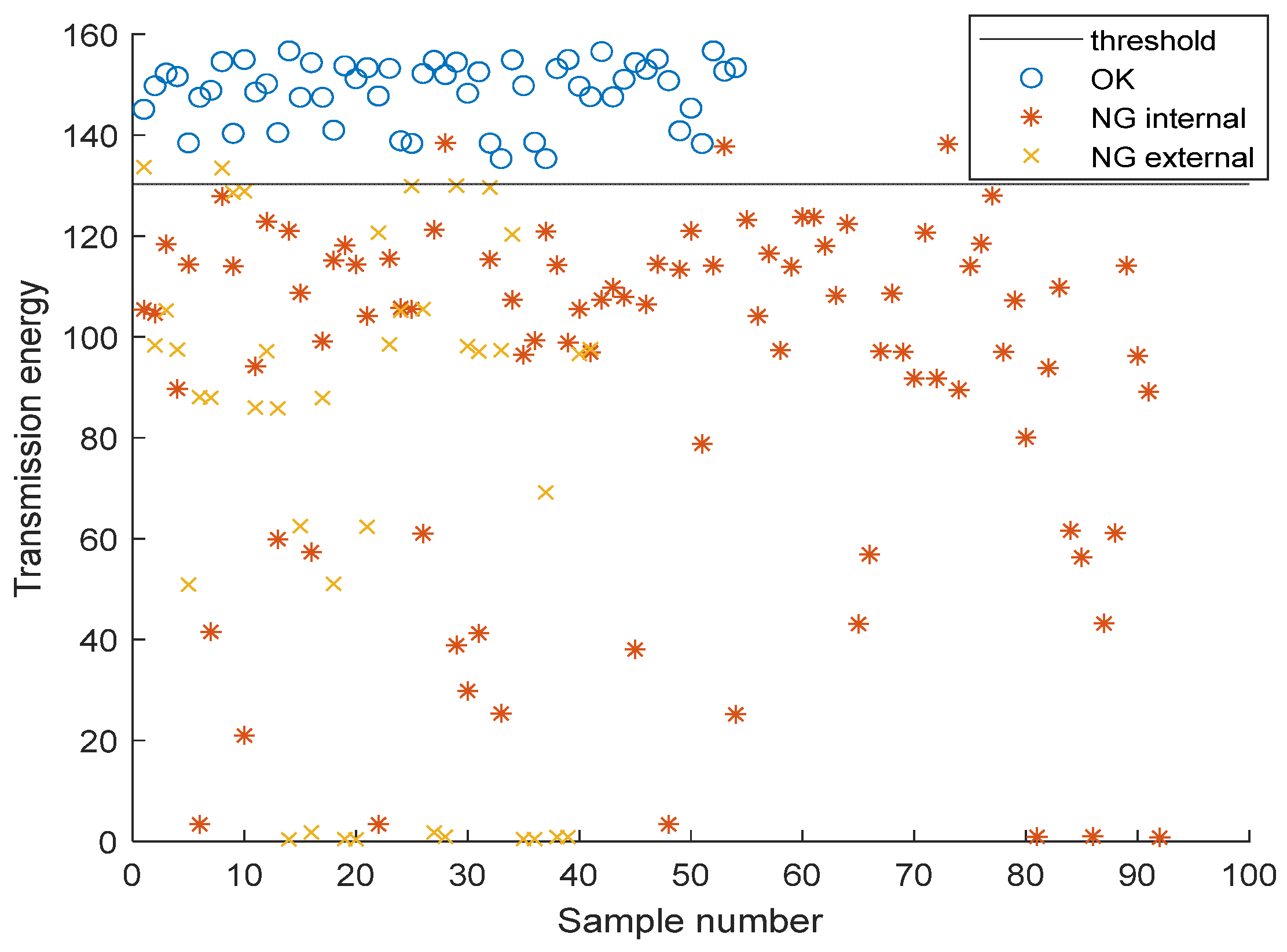
| Material | Acoustic Impedance gm/(cm2·s) | Sound Velocity (25 °C) km/s |
|---|---|---|
| Ferrite | 28.3 | 6.7 |
| Aluminum | 17.0 | 6.3 |
| Copper | 41.6 | 4.7 |
| Steel and Stainless | 45.4 | 5.8 |
| Iron | 45.4 | 5.9 |
| Magnesium | 10.1 | 5.77 |
Disclaimer/Publisher’s Note: The statements, opinions and data contained in all publications are solely those of the individual author(s) and contributor(s) and not of MDPI and/or the editor(s). MDPI and/or the editor(s) disclaim responsibility for any injury to people or property resulting from any ideas, methods, instructions or products referred to in the content. |
© 2023 by the authors. Licensee MDPI, Basel, Switzerland. This article is an open access article distributed under the terms and conditions of the Creative Commons Attribution (CC BY) license (https://creativecommons.org/licenses/by/4.0/).
Share and Cite
Huang, K.; Li, Q.; Zhu, K.; Chen, B.; Qian, X.; Wang, X.; Li, X. A Through-Transmission Ultrasonic Method for the Detection of Ferrite Tile Defects. Appl. Sci. 2023, 13, 11172. https://doi.org/10.3390/app132011172
Huang K, Li Q, Zhu K, Chen B, Qian X, Wang X, Li X. A Through-Transmission Ultrasonic Method for the Detection of Ferrite Tile Defects. Applied Sciences. 2023; 13(20):11172. https://doi.org/10.3390/app132011172
Chicago/Turabian StyleHuang, Kaiheng, Qiaolin Li, Kaixiong Zhu, Baihan Chen, Xiang Qian, Xiaohao Wang, and Xinghui Li. 2023. "A Through-Transmission Ultrasonic Method for the Detection of Ferrite Tile Defects" Applied Sciences 13, no. 20: 11172. https://doi.org/10.3390/app132011172





